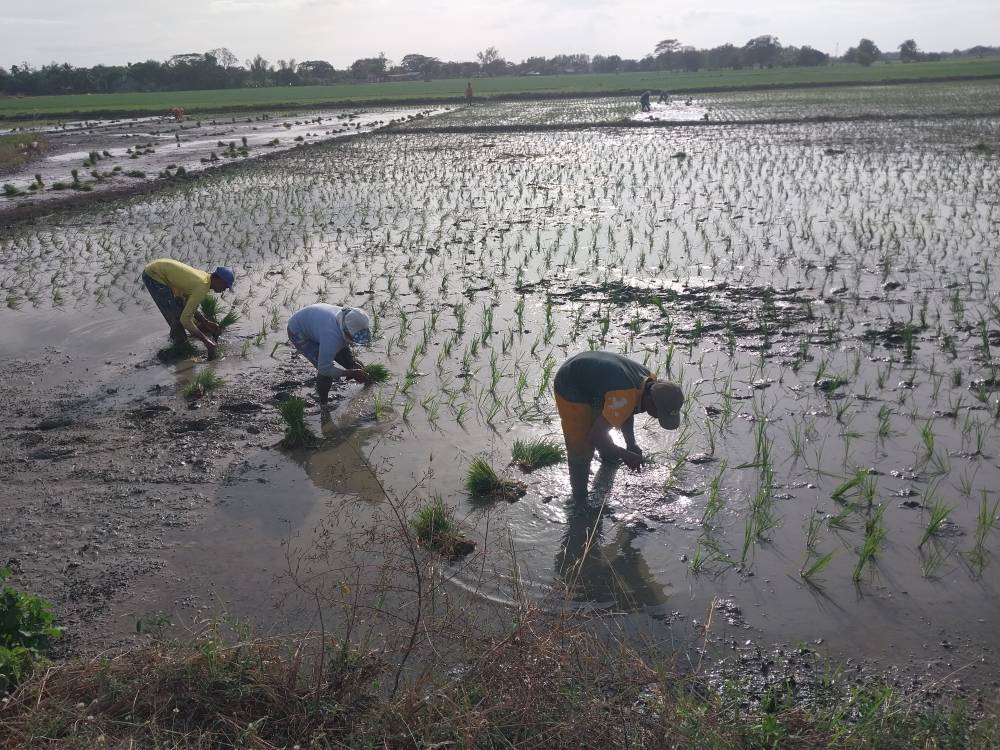
SOWING SEASON Rice farmers in Barangay Bakero in Cabanatuan City start planting in this photo taken on Jan. 17 to keep up with the scheduled irrigation of the National Irrigation Administration in time for the dry cropping season in Nueva Ecija. All seven provinces in Central Luzon are now experiencing a dry spell and a drought due to the continuing strong El Niño phenomenon at the start of this year. —ARMAND GALANG
The Department of Agriculture (DA) admits the El Niño-induced dry spell and external price and supply shocks would be the biggest threats to the industry this year.
Against this backdrop, Agriculture Secretary Francisco Tiu Laurel Jr. wants the entire DA staff to undertake a “very big mission”: to increase local production and lower the cost of producing agricultural commodities for the sake of both Filipino consumers and producers.
“The entire Philippines is watching us,” Laurel says. “And because the country’s attention is focused on us, we have to perform well.”
The swine industry, yet to fully recover from the mounting losses due to African swine fever (ASF), assures they will keep producing hogs even as production volume would be relatively unchanged.
“This extension is further damaging the confidence of local swine farmers, as farm-gate prices have been greatly affected, currently averaging P175 per kilogram, which is below the cost of production,” Pork Producers Federation of the Philippines Inc. president Rolando Tambago says.
National Federation of Hog Farmers Inc. president Chester Warren Tan says production will continue as scheduled even if they anticipate a slow recovery following the retention of low import duty on meat.
“Hog production will carry on but to be honest, we believe the sector’s recovery will slow down because of what happened (the extension of lowered import tariffs). But it does not mean production will stop,” Tan says.
Tambago pegs domestic pork output to remain the same as 2023 “with possible overall year-end negative growth.”
Traders are not that keen to bring in more imported meat either as Filipinos cut back on their pork and beef consumption amid retail prices remaining high.
Meat Importers and Traders Association president emeritus Jesus Cham says meat imports would remain almost the same despite the temporary modification of tariffs providing “more stability and certainty.”
“We have seen less imports in 2023 versus 2022. However, if consumption recovers and local pork remains high priced then there could be more,” Cham says.
For his part, Federation of Free Farmers national manager Raul Montemayor says the tariff reduction “sends the wrong signals to farmers at a time when we need them to expand production.”
Misleading Marcos
Montemayor believes President Marcos was blindsided when he made the decision, adding, “The economic managers withheld vital info from the president and effectively misled him.”
Groups claim the imposition of lower tariff rates since 2021 has failed to bring down retail prices of food in the market. Aside from losing billions of pesos in revenues, they argue it did not diversify the country’s sources of imported goods, specifically rice.
Earning the ire of many industry players is Executive Order (EO) No. 50, which extended the validity of reduced import tariffs on rice, corn and meat until the end of 2024.
Signed last Dec. 22, 2023, the EO maintained the tariff rate on imported rice at 35 percent for both in-quota and out-quota imports.
For meat (fresh, chilled, or frozen), the import duty is maintained at 15 percent for in-quota and 25 percent for out-quota. In the case of imported corn, the import duty remained at 5 percent for in-quota and 15 percent for out-quota.
The import duties, subject to a semestral review, are meant to keep food prices lower on the back of El Niño, the continued spread of ASF and the export ban in some countries.
Rizal Commercial Banking Corporation chief economist Michael Ricafort says the government needs to perform a “delicate” balancing act to manage any potential risk from EO No. 50.
Ricafort says this can be achieved by providing and managing better information, especially on demand-supply balance, to prevent undue competition with local production when there is a glut or oversupply.
Needed investments
The DA also says at least P1.3 trillion in investments would be needed over the next few years to boost rice production and cut agricultural waste.
Laurel says P1.2 trillion would go to the irrigation of 1.2 million hectares of farm lands dedicated to rice and some P90 billion would be earmarked for building integrated rice mill and warehouse complexes.
For this year alone, the agency set aside P1 billion to construct four cold storage facilities, mainly at the Food Terminal Inc. (FTI) complex in Taguig City.
These storage facilities, the DA says, will address oversupply and minimize postharvest losses, particularly from the spoilage of vegetables from Benguet.
It intends to develop a chiller warehouse dedicated to vegetables and other high-value crops on a 1.3-hectare section of FTI.
With a project cost of P500 million, the warehouse will feature a processing plant and trading area. This would prioritize farmers’ produce for buffer stocking.
The Philippine Statistics Authority (PSA) is yet to publish the latest reading on agricultural production in 2023. Likewise, the DA is yet to provide the growth target for this year as it is calibrating the projections as of press time.
Even so, the agency expects palay output to remain at the 20 million metric ton (MT) level given the possible constraints of El Niño on production.
Despite the gloomy outlook provided by industry stakeholders, DA spokesperson and assistant secretary Arnel de Mesa says agriculture production would grow albeit only in the 3- to 4-percent range.
The country’s farm output has been on a downtrend for the last three years after logging a modest increase in 2019.
Based on data from the PSA, agriculture output fell by 0.1 percent in 2022, smaller than the decline of 1.7 percent and 1.2 percent in 2021 and 2020, respectively.

